AMD FX-8350 Processor Review: Tuned-Up Bulldozer

Piledriver microarchitecture, a refreshed Bulldozer, has finally reached the flagship AMD FX processors. Will it make the Socket AM3+ platform more appealing than LGA 1155? Quite possible, because the new AMD microarchitecture wasn’t the only trick they had up their sleeve.
A year ago AMD introduced their principally new Bulldozer microarchitecture and desktop processors based on it. However, there wasn’t much to be raving about: the company still didn’t manage to catch up with Intel’s microprocessor architectures in efficiency, so at that point AMD remained behind, at least in the high-performance segment. However, no one was ready to give up on AMD yet, and here is why.
First of all, Bulldozer is the first version of a radically new processor design. And it was quite natural that it wasn’t all so polished off and optimized yet. For example, the current high-performance Intel processors are already using the fourth generation of the Core microarchitecture that is why it is quite logical that it boasts very impressive efficiency at this point. AMD engineers haven’t yet had time to fix or improve things about their design, although there is a lot of opportunity for optimizations in Bulldozer. Therefore, for the next few years, while the fresh AMD microarchitecture continues to accumulate improvements and to mature, the performance of processors based on it could increase significantly. By the way, this is what they made clear during the original launch. According to the engineers, the performance of high-end AMD products should improve by at least 10-15% per year with each new iteration of processor design improvements.
Secondly, despite all the concerns about the first CPUs with Bulldozer microarchitecture, they undoubtedly have quite a few great things going on in them, which can eventually pay off big. The design concept of contemporary high-performance AMD products implies the use of a larger number of simplified computing cores working at higher frequencies. Keeping in mind the ever-growing popularity of parallel calculations, this approach should one day produce great results. Therefore, AMD engineers have a very good reason to remain loyal to their unique strategy.
The only real threat to the Bulldozer’s successors could be the fact that AMD may run out of persistence and willpower to fully perfect these products. The company’s current market situation is not very favorable and there is massive restructuring going on, where the development of high-performance desktop processors I not a top priority task. Of course, this microarchitecture is currently also used in the company’s hybrid products, so it won’t sink into total oblivion. However, such change of primary targeting may also shift the overall focus from performance to energy efficiency, which may be fatal for the higher-end desktop segment.
Nevertheless, let’s not start panicking ahead of time. So far there is no indication that AMD decided to give up the high-end segment. Moreover, today the company is launching desktop processors on Piledriver microarchitecture – an enhanced modification of their Bulldozer, which should deliver the promised annual performance boost.
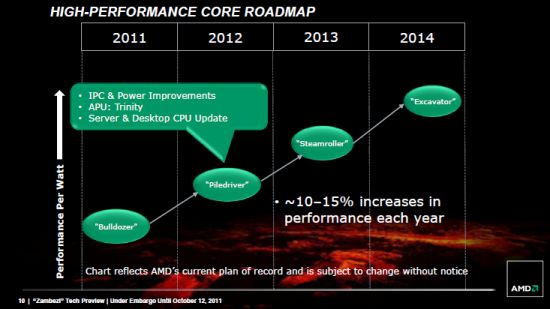
To be more exact, Piledriver microarchitecture is not really that new. It has been used for a while in the company’s hybrid processors known as Trinity in mobile products as well as in Socket FM2 platform. However, this is exactly the case when the use of an APU doesn’t let the microarchitecture to really shine to the utmost of its potential. Trinity processors have a limited number of computing cores, do not have an L3 cache and their clock speeds are not at the highest. Therefore, they are not really representative of the true potential of the new microarchitecture.
The traditional desktop CPUs on Piledriver microarchitecture are a much more interesting animal. They are going to be the topic of our today’s detailed discussion. In our today’s review, we will talk about the new AMD processors also known as Vishera, which continue the FX family of products established by the Zambezi processors on Bulldozer microarchitecture. Vishera are destined to hold AMD’s positions in the desktop segment during the upcoming holiday season and for almost the entire next year, i.e. until AMD is ready to roll out their next design aka Steamroller.
Piledriver Microarchitecture and Vishera Processors
It is obvious that one wave of improvements wasn’t enough to eliminate all concerns related to Bulldozer. It was almost impossible to design and implement any radical changes over the year that has gone since the launch of the new microarchitecture. Besides, the production technologies available at the disposal of AMD’s manufacturing partners haven’t been improved either. Therefore there was every formal indication that Vishera processor design based on Piledriver microarchitecture should be regarded as the first and pretty superficial optimization. It won’t be until in about a year that we can finally see some radical enhancements and changes, when AMD introduced 22 nm process and finishes working on their Steamroller microarchitecture.
The formal characteristics of the semiconductor Vishera die make it very similar to Zambezi. Both of them are manufactured with 32 nm process, consist of 1.2 billion transistors, are about 315 mm2 big and have eight computing cores and an 8 MB L3 cache each. The basic principles of internal core organization also remained the same. They are paired in modules, with some functional units being shared between the two cores. These shared resources include not only the L2 cache, but also the floating-point unit as well as the instructions fetcher and instruction decoder. In other words, the maximum instruction execution rate in Piledriver processors remained the same: dual-core modules with this microarchitecture are unable to execute more than four instructions per clock cycle.
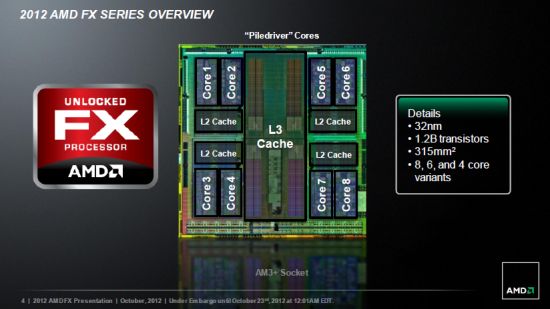
Nevertheless, AMD engineers still managed to speed up their Piledriver processors without modifying their basic structure and blowing the transistor count out of proportion. They accomplished it with minor enhancements in two directions.
First, they have seriously modified the internal core structure. If you take a closer look at the Vishera semiconductor die, you will easily notice that it is very different from Zambezi.
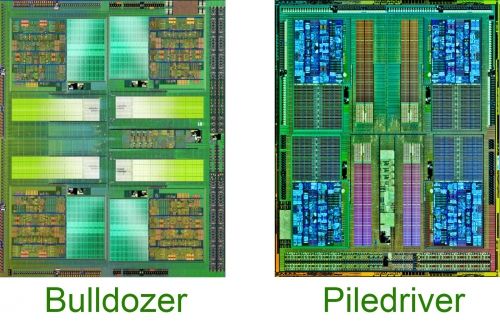
The restructuring enabled processors on Piledriver microarchitecture to work at higher frequencies even without any changes in the manufacturing process. Vishera are the first multi-core desktop processors, which nominal clock frequency ahs reached 4 GHz.
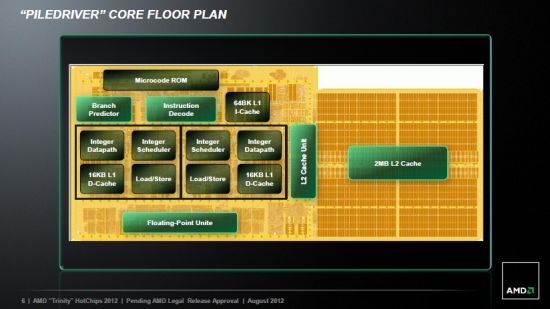
Second, engineers managed to increase the specific cores performance. Of course, we aren’t talking about any serious performance boost, but even minor adjustments turned out very efficient in the end. Front End now has a more precise branch predictor and a larger instruction window. The execution units acquired an enhanced scheduler and learned to process individual instructions faster, such as integer and floating-point division, for example. Moreover, the developers claim that they have increased the L1 TLB size and improved the data prefetch and arbitrating algorithms in the L2 cache.
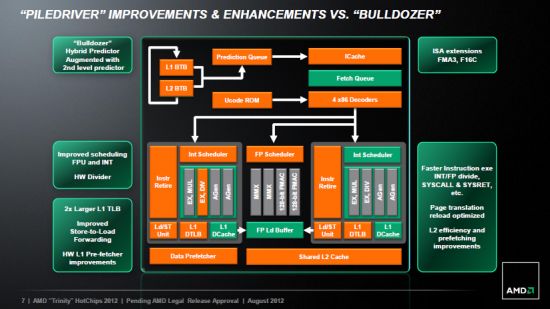
As a result, the refreshed FX processor lineup on the Vishera design expands the Zambezi family “up” and offers similar models, but with higher clock speeds and better performance. And keeping in mind AMD’s evolutionary, rather than revolutionary modifications and optimizations, they logically decided not to introduce any new platforms, sockets or chipsets. New processors will smoothly replace their predecessors and will offer AMD fans another option for upgrading their existing systems.
At the time of launch Vishera processor family will have four members: two eight-core, one six-core and one quad-core processor. The table below sums up their specifications:
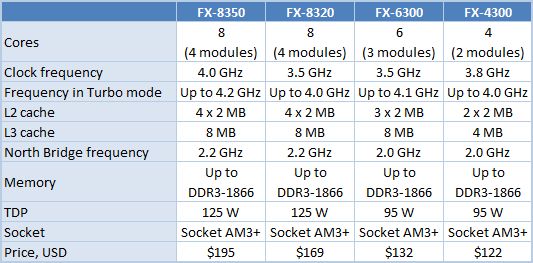
Those of you, who are already familiar with the previous AMD products, will find the new FX specifications to be quite logical. The clock speeds are higher, the TDP remains at the familiar level. However, there are a few other innovations. For example, the new quad-core FX processor will now have an L3 cache of only half the size, and the clock frequencies of the quad- and six-core processors are set at a lower level than those of the eight-core models. In the previous processor line-up it was just the contrary: the maximum clock speeds belonged to the CPUs with fewer cores. It most likely indicates that from now on AMD will focus more aggressively on their top FX offering, while previously their processors with lower core count were the ones with the most optimal combination of consumer features. In other words, it seems that the manufacturer is very optimistic that their FX-8350 Vishera processor turns out much more competitive than the FX-8150 from Zambezi generation.
And there is another good reason for that, besides the new microarchitecture and increased clock speed. It is the price. While a year ago when AMD introduced their eight-core FX processors, they positioned them as a better alternative to Core i5, today they have seriously revised their pricing vision. The top eight-core Vishera, FX-8350 processor, will cost even less than Core i5-3570K. And it means that from now on AMD considers their high-performance processor family capable of competing successfully against Core i5 CPUs, but not the faster and more expensive kind. In fact, it seems to be just as important of an advantage of the new FX family, as the new microarchitecture or increased frequency potential. Taking into account the price tag, new eight-core products will undoubtedly be of interest to a lot of users out there. Really, the top FX processors are truly unique in some way: no other desktop processor family can boast models with so many cores.
Closer Look at AMD FX-8350
For our tests we received AMD’s most interesting product – the top CPU in the refreshed FX family with Vishera design – FX-8350. You can check out its formal characteristics in the following CPU-Z screenshot:
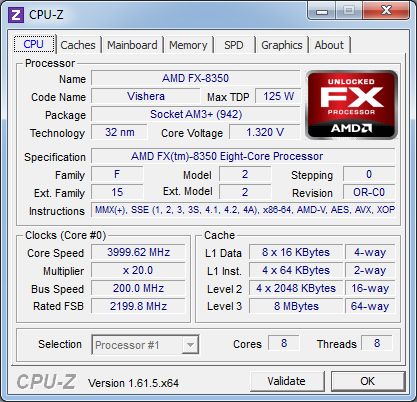
I would like to remind you that this processor consists of four dual-core modules. Each module has its own shared 2 MB of L2 cache memory, and the entire processor has a shared 8 MB L3 cache. Like in their predecessors, the L3 cache and the dual-channel memory controller in Vishera based processors belong to the North Bridge, which works at its own frequency. For FX-8350 it is set at 2.2 GHz.
The nominal frequency for the FX-8350 is set at 4.0 GHz, but the processor supports Turbo Core technology, which can automatically overclock it to 4.2 GHz. This technology has become much more aggressive in the new processors than it was before. Now they can hit the maximum frequency even if all the computing cores are utilized. In other words, Turbo Core can now boost the performance not only in low-threaded environments but also during maximum thread count.
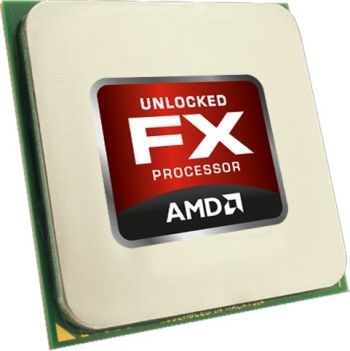
I would like to draw your attention to another interesting thing. FX-8350 processor has OR-C0 stepping, while the previous generation mass production processors used OR-B2 stepping. It is a clear indication that AMD views their new processor design not as an individual product, but merely as another revision of the original Orochi core.
Testbed Configuration and Testing Methodology
Since the new AMD FX-8350 is priced lower than the competitor’s top LGA 1155 processors, we will compare it against the junior quad-core Intel processors, besides the traditional Core i5-3570K and Core i7-3770K. They are Core i5-3470 and Core i5-3330. Of course, we also included the top Socket AM3+ processor from the previous generation – AMD FX-8150.
As a result, our testbeds were built with the following hardware and software components:
- Processors:
- AMD FX-8350 (Vishera, 8 cores, 4.0-4.2 GHz, 4 x 2 MB L2, 8 MB L3);
- AMD FX-8150 (Zambezi, 8 cores, 3.6-4.2 GHz, 4 x 2 MB L2, 8 MB L3);
- Intel Core i7-3770K (Ivy Bridge, 4 cores + HT, 3.5-3.9 GHz, 4 x 256 KB L2, 8 MB L3);
- Intel Core i5-3570K (Ivy Bridge, 4 cores, 3.4-3.8 GHz, 4 x 256 KB L2, 6 MB L3).
- Intel Core i5-3470 (Ivy Bridge, 4 cores, 3.2-3.6 GHz, 4 x 256 KB L2, 6 MB L3);
- Intel Core i5-3330 (Ivy Bridge, 4 cores, 3.0-3.2 GHz, 4 x 256 KB L2, 6 MB L3).
- Processor cooler: NZXT Havik 140;
- Mainboards:
- ASUS Crosshair V Formula (Socket AM3+, AMD 990FX + SB950);
- ASUS P8Z77-V Deluxe (LGA1155, Intel Z77 Express).
- Memory: 2 x 4 GB, DDR3-1866 SDRAM, 9-11-9-27 (Kingston KHX1866C9D3K2/8GX).
- Graphics card: NVIDIA GeForce GTX 680 (2 GB/256-bit GDDR5, 1006/6008 MHz).
- Disk drive: Intel SSD 520 240 GB (SSDSC2CW240A3K5).
- Power supply unit: Corsair AX1200i (80 Plus Platinum, 1200 W).
- Operating system: Microsoft Windows 7 SP1 Ultimate x64.
- Drivers:
- AMD Chipset Driver 12.8;
- Intel Chipset Driver 9.3.0.1019;
- Intel Graphics Media Accelerator Driver 15.?26.?12.?2761;
- Intel Management Engine Driver 8.?1.?0.?1248;
- Intel Rapid Storage Technology 11.?2.?0.?1006;
- NVIDIA GeForce 301.42 Driver.
For our tests of the Socket AM3+ platform we installed KB2645594 and KB2646060 OS patches, which adapt the scheduler operation for Bulldozer and Piledriver microarchitectures.
Performance
Piledriver vs. Bulldozer: How Serious Are Microarchitectural Advantages?
When we described the innovations AMD introduced in their new processor design, we kept stressing that they weren’t too significant. However, many of you are most likely wondering about the specific performance boost resulting from the microarchitectural improvements and from the clock frequency increase. Therefore, before we proceed with the actual performance tests in applications, we decided to pay special attention to a comparison between Vishera and Zambezi working at the same clock frequencies. For this round of tests we selected two eight-core processors from different AMD FX generations and manually set their frequency to 4.0 GHz. Turbo Core technology was disabled. Since other characteristics of Vishera and Zambezi processors are the same, the obtained results demonstrate the effect from replacing the Bulldozer microarchitecture with Piledriver.
Artificial comparisons like that are best performed in synthetic benchmarks. A popular SiSoftware Sandra SP5c suite offers a very good set of tests for that. Let’s use them:
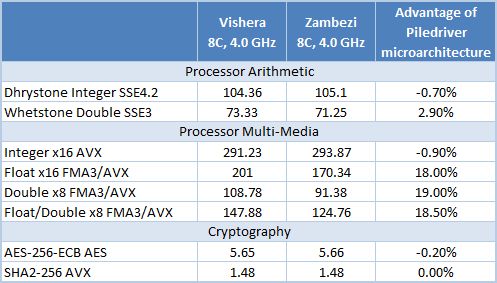
Overall, I have to admit that the microarchitectural improvements introduced in new processors did not boost their performance that much after all. Although in some tests we see an almost 20% acceleration in the floating-point operations, it is important to understand that it results primarily from the FMA3 instructions support introduced in the Piledriver processors, which is missing in the original Bulldozer microarchitecture. General-purpose applications can hardly boast the same efficiency with new instructions, especially since Intel processors will only acquire similar functionality in the upcoming Haswell CPUs. Therefore, new AMD microarchitecture can only boost the performance in everyday tasks by a few percent. We owe most of the performance improvement to the increased clock frequency.
However, Vishera boasts another important advantage: increased cache-memory efficiency. For example, Cachemem test from the Aida64 2.60 suite shows a significant increase in the cache memory bandwidth almost with any operations. Our only concern is the read speed from L2 cache, which has dropped down by half, but in this case it seems to be more of the benchmark peculiarity rather than a microarchitectural issue.
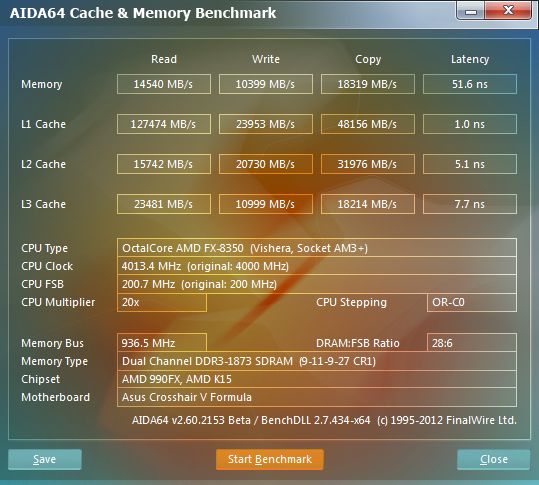
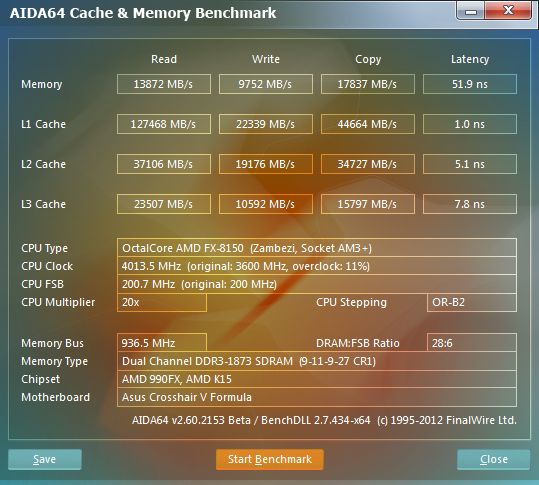
However, engineers decided not to provide Vishera processors with support for additional multipliers in the memory controller. Just like with Zambezi, the maximum supported memory mode is DDR3-2400. If you want to equip your Socket AM3+ system with even faster memory, which is already widely available in the market, then you would need to increase the base generator clock.
Let’s sum up a few things. The performance of the new AMD processors improved mostly due to the higher clock frequencies, more aggressive Turbo Core technology and faster cache-memory. Hypothetically, the support of new instruction sets implemented in the Piledriver processors could also help improve the performance in floating-point calculations, but the software developers aren’t rushing to integrate them just yet.
Will these improvements help to resolve the low specific efficiency of the AMD cores? Let’s check out the results of another benchmark, which makes all the pros and cons of the new AMD microarchitecture very obvious. The graph below shows the performance of AMD and Intel processors in Fritz Chess Benchmark, which creates a different number of simultaneous computing threads.
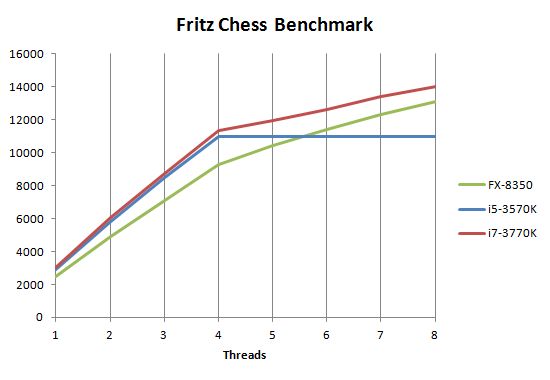
The two major bottlenecks of Vishera processor design are right there in the open: they obviously didn’t go anywhere and have simply migrated from the Bulldozer. First, the performance of individual FX-8350 cores is significantly lower than that of the cores in contemporary Intel processors. Second, when more than four cores of the FX-8350 processor are utilized, the performance gain from adding new cores to the equation is lower because of the “paired” design. As a result, the eight-core AMD FX-8350 can only compete successfully against the quad-core Core i5-3570K when the operational load has more than six threads. As for the Core i7-3770K, the flagship AMD processor can’t get even close to it: the performance of the Intel CPU in case of more than four threads continues to increase due to Hyper-Threading technology.
General Performance
As usual, we use Bapco SYSmark 2012 suite to estimate the processor performance in general-purpose tasks. It emulates the usage models in popular office and digital content creation and processing applications. The idea behind this test is fairly simple: it produces a single score characterizing the average computer performance.
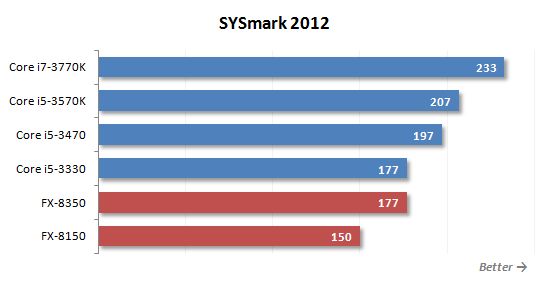
Compared with the predecessor, AMD FX-8350 does very well here: it is 18% faster. As a result, the new AMD processor competes against the junior models of Intel Core i5 with Ivy Bridge design. However, I have to remind you that AMD’s strengths become more obvious during multi-threaded loads, so the relative performance of the eight-core Vishera may differ as we move from one application to another.
Let’s take a closer look at the performance scores SYSmark 2012 generates in different usage scenarios. Office Productivity scenario emulates typical office tasks, such as text editing, electronic tables processing, email and Internet surfing. This scenario uses the following applications: ABBYY FineReader Pro 10.0, Adobe Acrobat Pro 9, Adobe Flash Player 10.1, Microsoft Excel 2010, Microsoft Internet Explorer 9, Microsoft Outlook 2010, Microsoft PowerPoint 2010, Microsoft Word 2010 and WinZip Pro 14.5.
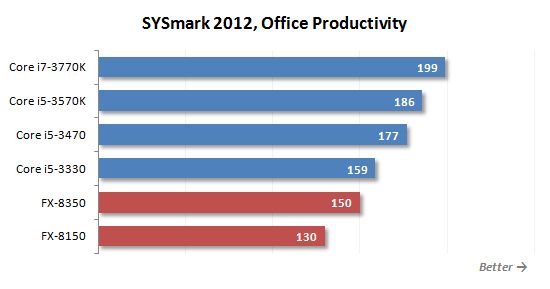
Media Creation scenario emulates the creation of a video clip using previously taken digital images and videos. Here they use popular Adobe suites: Photoshop CS5 Extended, Premiere Pro CS5 and After Effects CS5.
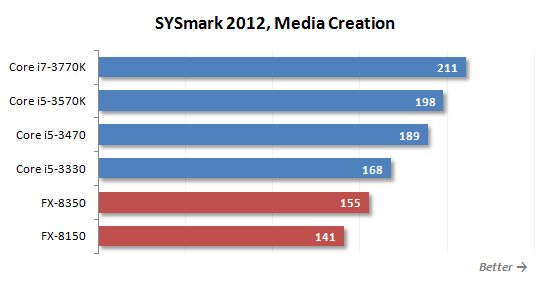
Web Development is a scenario emulating web-site designing. It uses the following applications: Adobe Photoshop CS5 Extended, Adobe Premiere Pro CS5, Adobe Dreamweaver CS5, Mozilla Firefox 3.6.8 and Microsoft Internet Explorer 9.
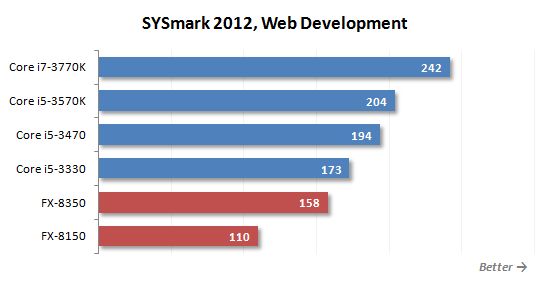
Data/Financial Analysis scenario is devoted to statistical analysis and prediction of market trends performed in Microsoft Excel 2010.
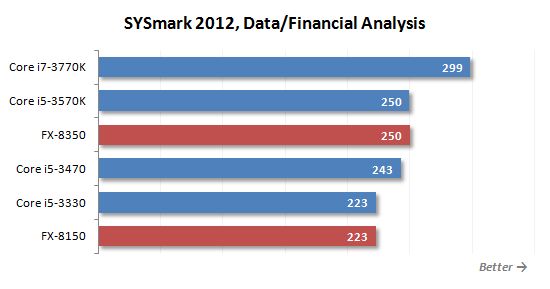
3D Modeling scenario is fully dedicated to 3D objects and rendering of static and dynamic scenes using Adobe Photoshop CS5 Extended, Autodesk 3ds Max 2011, Autodesk AutoCAD 2011 and Google SketchUp Pro 8.
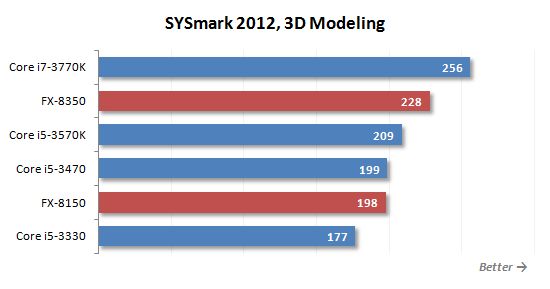
The last scenario called System Management creates backups and installs software and updates. It involves several different versions of Mozilla Firefox Installer and WinZip Pro 14.5.
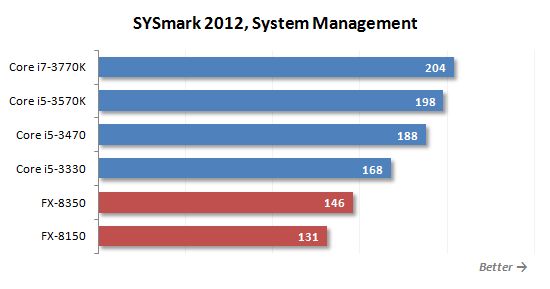
The new AMD processor yields to Intel Core i5 CPUs in typical office applications, during HD video content creation and processing and in system tasks. It is quite logical: the specific performance of the paired AMD cores is not too high, so if the load is not split into eight equal parallel threads, then there is no way FX-8350 or FX-8150 demonstrate high results. However, Vishera processor can do just as good as the top Core i5 from the Ivy Bridge generation when working on heavy calculations, like statistical analysis of large data arrays or in 3D modeling tasks. Overall, AMD FX-8350 performance proves to be quite adequate to its price in general-purpose tasks and applications.
Gaming Performance
As you know, it is the graphics subsystem that determines the performance of the entire platform equipped with pretty high-speed processors in the majority of contemporary games. Therefore, we do our best to make sure that the graphics card is not loaded too heavily during the test session: we select the most CPU-dependent tests and all tests are performed without antialiasing and in far not the highest screen resolutions. In other words, obtained results allow us to analyze not that much the fps rate that can be achieved in systems equipped with contemporary graphics accelerators, but rather how well contemporary processors can cope with gaming workload. Therefore, the results help us determine how the tested CPUs will behave in the nearest future, when new faster graphics card models will be widely available.
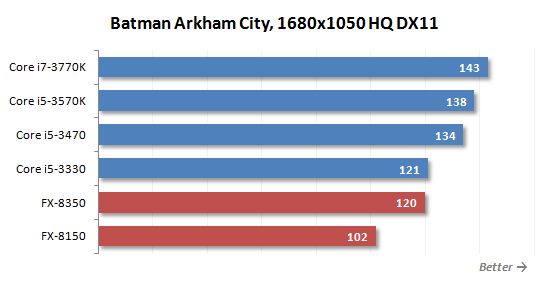
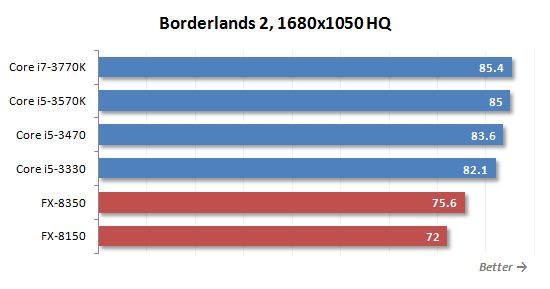
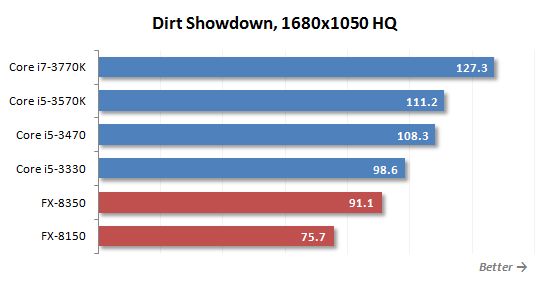
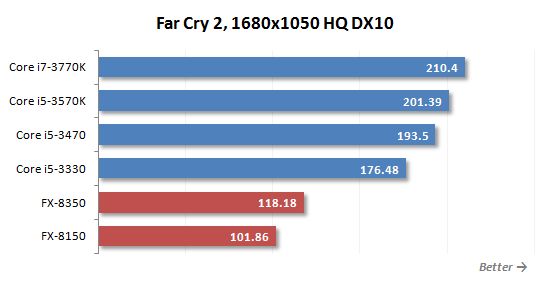
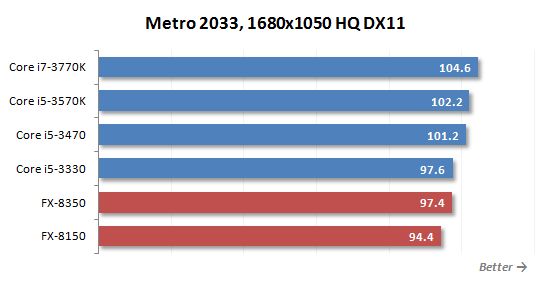
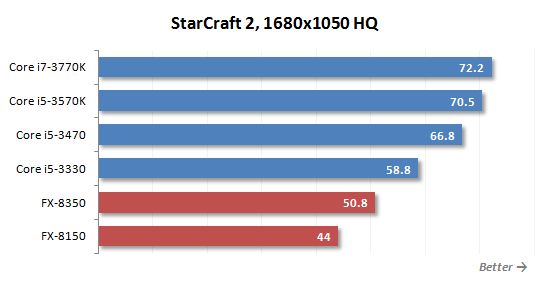
The gaming performance of the Bulldozer processors was an indisputable catastrophe. The AMD’s design of choice with a large number of paired cores didn’t do well in old and new games, which resulted into a truly dramatic gap between the AMD FX-8150 and Intel Core i5 processors. We didn’t expect any serious changes in this aspect from the new Piledriver microarchitecture, because it uses the same basic design principles. Nevertheless, the implemented improvements as well as increased clock frequency did boost the fps rate quite noticeably. However, it is still not enough. Intel’s Core i5 remain the best gaming processor with a pretty significant performance advantage. In other words, we continue to claim that contemporary gaming systems shouldn’t be built on Socket AM3+ platforms.
In addition to our gaming tests we would also like to offer you the results of the Futuremark 3DMark11 benchmark (Performance profile):
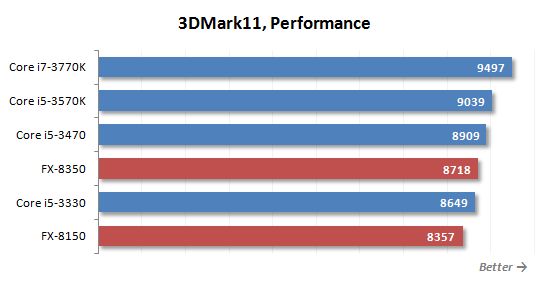
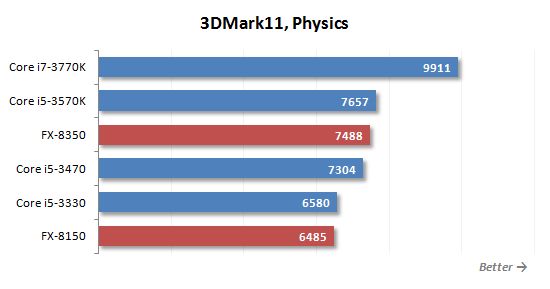
The situation here is a little more cheerful. AMD FX-8350 is over 4% faster than its predecessor in total score, and over 15% faster in physical modeling speed. As a result, the new AMD processor demonstrates a level of performance comparable to that of Core i5-3470. However, do not forget that 3DMark 11 is a benchmark with excellent multi-threading support.
Performance in Applications
To test the processors performance during data archiving we resort to WinRAR archiving utility. Using maximum compression rate we archive a folder with multiple files with 1.1 GB total size.
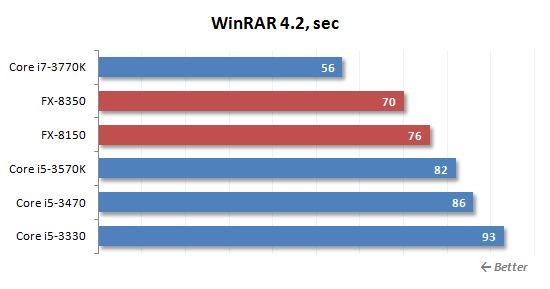
The developers of the popular WinRAR archiving tool have recently optimized their product for systems with multi-core processors. As a result, eight-core AMD processors started doing very well in this test. This is why the new FX-8350 outperforms the top Core i5 CPU here. However, it is still unable to beat the Core i7-3770K with Hyper-Threading technology.
The processor performance in cryptographic tasks is measured using a built-in benchmark of the popular TrueCrypt utility that uses AES-Twofish-Serpent “triple” encryption. I have to say that this utility not only loads any number of cores with work in a very efficient manner, but also supports special AES instructions.
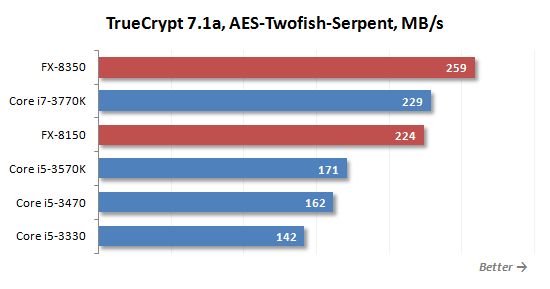
Eight cores and AVX instructions support help processors with Bulldozer and Piledriver microarchitectures to cope pretty well with data encryption tasks. And FX-8350, which runs about 15% faster than its predecessor, outperforms even the top quad-core competitor – Core i7-3770K.
Now that the eighth version of the popular scientific Mathematica suite is available, we decided to bring it back as one of our regular benchmarks. We use MathematicaMark8 integrated into this suite to test the system’s performance :
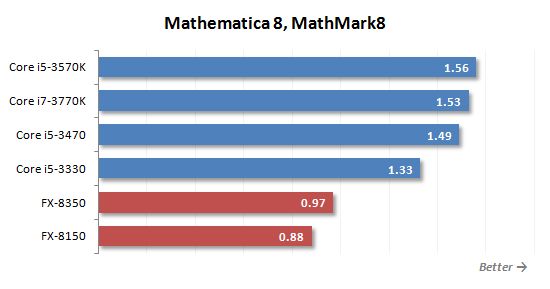
And in Wolfram Mathematica AMD products have totally failed. Paired floating-point units and a decoder with limited throughput make contemporary AMD microarchitecture very vulnerable in this testing suite. As a result, even the new FX-8350 is significantly behind the junior contemporary Core i5.
We measured the performance in Adobe Photoshop CS6 using our own benchmark made from Retouch Artists Photoshop Speed Test that has been creatively modified. It includes typical editing of four 24-megapixel images from a digital photo camera.
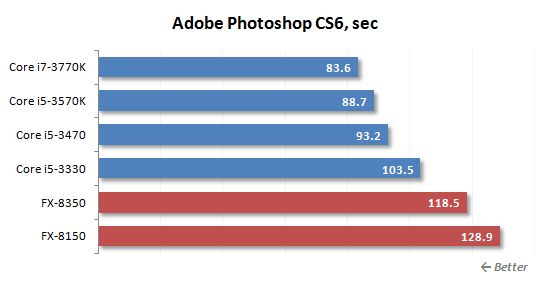
Intel processors have long boasted high performance results in Adobe Photoshop. The arrival of Bulldozer didn’t change anything. The new version of this microarchitecture, Piledriver, implemented in the new FX-8350, also didn’t have any significant effect. The new AMD processor turned out about 9% faster than FX-8150, but it still falls behind the junior quad-core CPU with Ivy Bridge microarchitecture.
The performance in Adobe Premiere Pro CS6 is determined by the time it takes to render a Blu-ray project with a HDV 1080p25 video into H.264 format and apply different special effects to it.
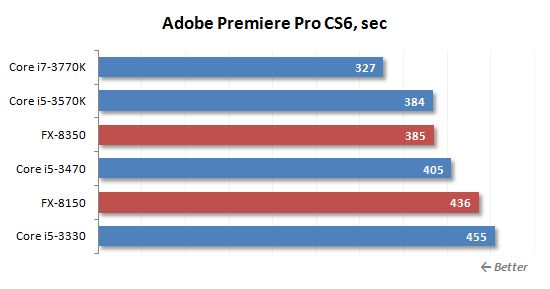
High-definition video content processing is an excellent example of well-paralleled load. Multi-core architectures should feel at home in tasks like that, which is exactly what we see in the diagram. Eight-core AMD FX-8350 processor does way better here than in many other cases. It runs as fast as Core i5-3570K. However, Intel Core i7-3770K with four cores and Hyper-Threading support is still considerably faster than the new AMD product.
In order to measure how fast our testing participants can transcode a video into H.264 format we used x264 HD Benchmark 5.0. It works with an original MPEG-2 video recorded in 1080p resolution with 20 Mbps bitrate. I have to say that the results of this test are of great practical value, because the x264 codec is also part of numerous popular transcoding utilities, such as HandBrake, MeGUI, VirtualDub, etc.
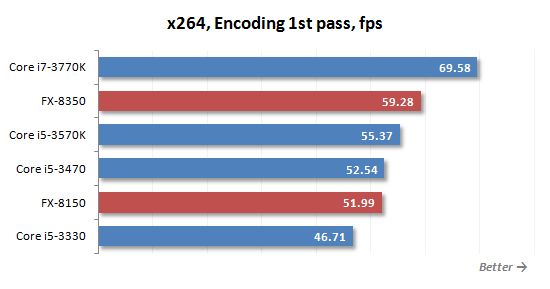
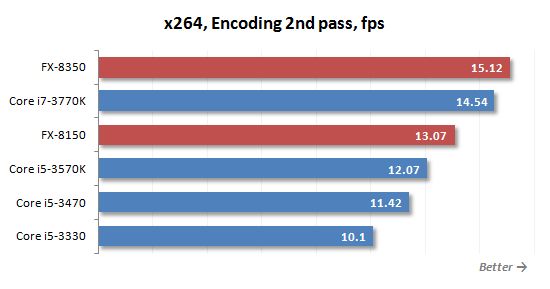
Video transcoding with the x264 codec is an example of an ideal task for contemporary AMD processors. Here FX-8350 demonstrates 15% better results than its predecessor on Zambezi design, and is faster than any of the LGA 1155 Intel CPUs during the heaviest second transcoding pass. It partially owes its success to the use of new TBM, FMA3 and BMI1 instructions supported by the Piledriver microarchitecture.
Following our readers’ requests, we’ve added a new HD video benchmark to our tests. SVPmark3 shows the computer performance in the SmoothVideo Project application which makes videos smoother by adding new intermediary frames. The numbers in the diagram reflect the speed of processing Full HD videos without the graphics card’s help.
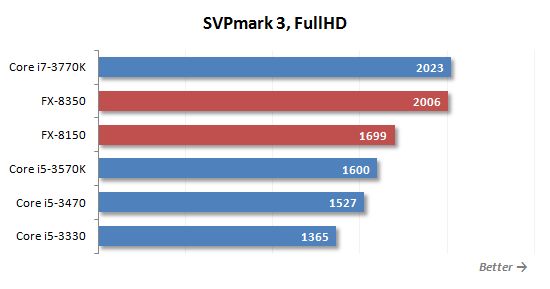
Here the new FX-8350 doesn’t work as fast as Core i7-3770K, but its performance is nevertheless quite impressive: it is 25% faster than Core i5-3570K.
We will test computational performance and rendering speeds in Autodesk 3ds max 2011 using the special SPECapc for 3ds max 2011 benchmark:
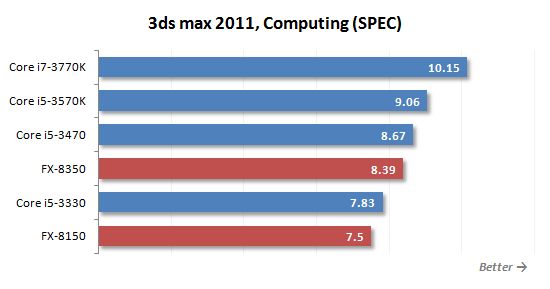
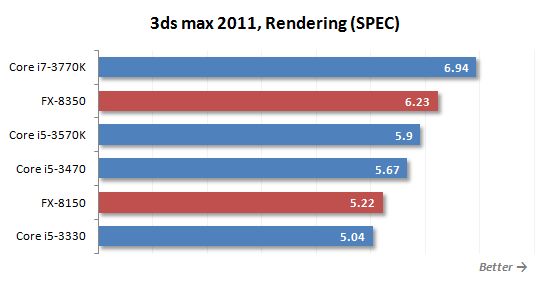
During rendering in 3ds max 2011 we see the highest performance improvement that occurs during the AMD processor generation change. FX-8350 is almost 20% faster than FX-8150. As a result, the performance of the newcomer on Piledriver microarchitecture falls between that of Core i5-3570K and Core i7-3770K. This is an undeniable success for a sub-$200 processor.
We use special Cinebench 11.5 benchmark to test final rendering speed in Maxon Cinema 4D suite.
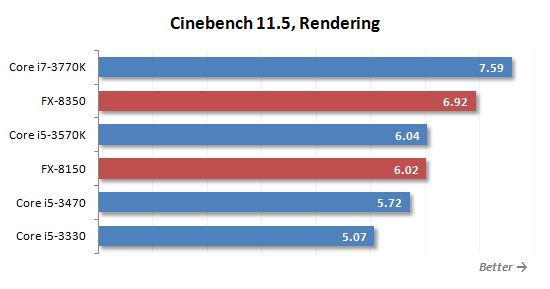
The performance of the AMD FX-8150 processor in Cinebench test used to be ridiculously low, but now things have improved dramatically. FX-8350 is now 15% faster and therefore it outperforms Core i5-3570K. However, Core i7-3770K is even faster than that, which means that a dual-core Piledriver module is still not as fast as a single Ivy Bridge core with enabled Hyper-Threading technology.
Power Consumption
Frankly speaking, we have no reason to expect the new processors on Piledriver microarchitecture to offer us anything new in terms of heat dissipation and power consumption compared with the predecessors. The manufacturing technology is the same for Zambezi and Vishera designs: both are made with 32 nm process. Yes, the semiconductor die in the new processors has been restructured in order to reduce its heat dissipation. But all the potential gained in this case was immediately invested into the clock frequency increase in the FX processors. As a result, the new Vishera CPUs have the same exact TDP as their predecessors. But this is just theory. What does reality look like?
To get a better idea of how greatly the processor’ energy efficiency actually improved we performed a round of special tests. The new digital power supply unit from Corsair – AX1200i – allows monitoring consumed and produced electrical power, which we use actively during our power consumption tests. The graphs below (unless specified otherwise) show the full power draw of the computer (without the monitor) measured after the power supply. It is the total power consumption of all the system components. The PSU’s efficiency is not taken into account. The CPUs are loaded by running the 64-bit version of LinX 0.6.4-AVX utility. Moreover, we enabled Turbo mode and all power-saving technologies to correctly measure computer’s power draw in idle mode: C1E, C6, Enhanced Intel SpeedStep and AMD Cool’n’Quiet.
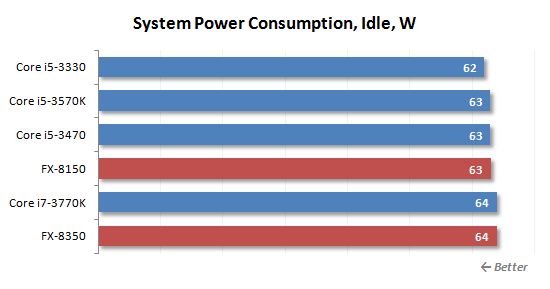
In idle mode all processors and platforms consume about the same power. In idle mode any contemporary processors will switch to special power-saving states, in which their power consumption will be very low – only a few watts. In this case the power appetites of other system components and the efficiency of the voltage regulator circuitry on the mainboard start to matter more and they partially mask the pure processor power consumption.
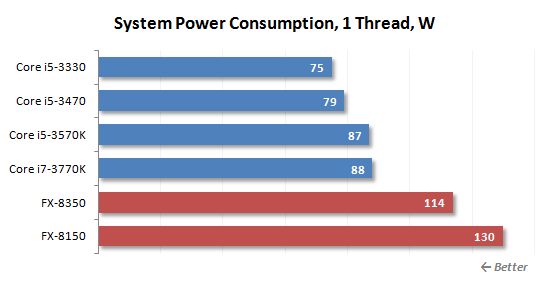
In case of single-threaded load AMD processors already start revealing their appetite for power. In this case systems built on these processors need about one and a half times more power than any contemporary LGA 1155 configurations. At the same time, the performance of AMD processors with this type of load is significantly lower than that of Intel processors. However, the new FX-8350 seems to have become a little more energy-efficient compared with the FX-8150.
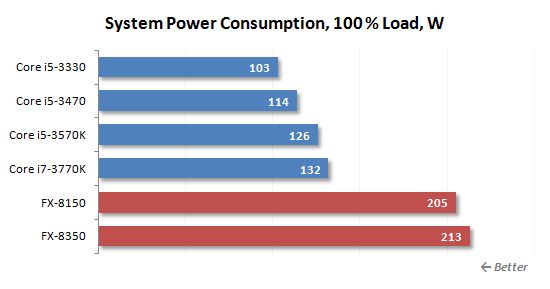
Under heavy load the things are even worse for Socket AM3+ platform. In the end Vishera processor turned out even less energy-efficient than its predecessor, therefore the comparison against an LGA 1155 system based on a 22 nm Ivy Bridge processor end up really sad for AMD. In fact, even though Vishera’s performance sometimes made it seem like a very appealing product, the energy-efficiency aspect creates an insurmountable barrier between them.
Overclocking
In conclusion we would like to check out yet another promising aspect of the new Vishera processor family, because AMD had promised us not only higher performance, but also higher overclocking potential. This could make the new AMD processor even more appealing for computer enthusiasts. All FX processors, both old and new ones, belong to the Black Edition series, i.e. have unlocked clock frequency multipliers. And since the junior Intel processor with the same feature is Core i5-3570K, it turns out that AMD FX is an excellent choice for enthusiasts on a budget. All we need now is the frequency potential.
However, AMD processors on Piledriver microarchitecture have nothing to worry about. Even the previous generation Zambezi processors could be easily overclocked to 4.6 GHz with just air cooling. The new Vishera design promises even higher maximum frequencies. And our practical experiments confirmed that fully. We managed to overclock our AMD FX-8350 with our irreplaceable NZXT Havik 140 cooler to 4.7 GHz without any stability losses.
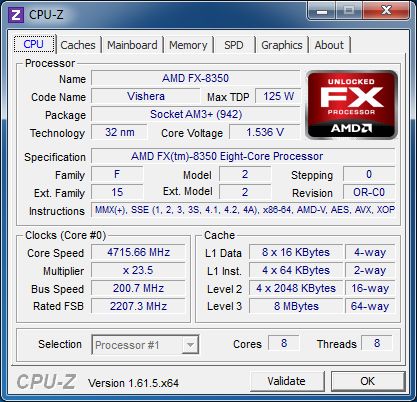
To ensure that the system will work stably at this frequency we had to push the processor core voltage to 1.54 V and enabled Load Line Calibration. However, despite these extra measures, the temperature remained within an acceptable range. According to the processor thermal sensor, the hottest core didn’t exceed 70°C and the overall CPU temperature stayed below 80°C, according to the mainboard thermal sensor under the processor socket.
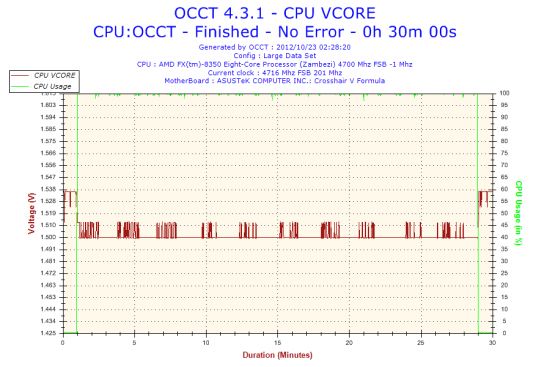
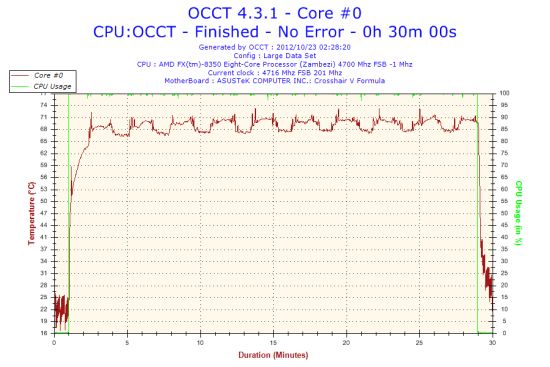
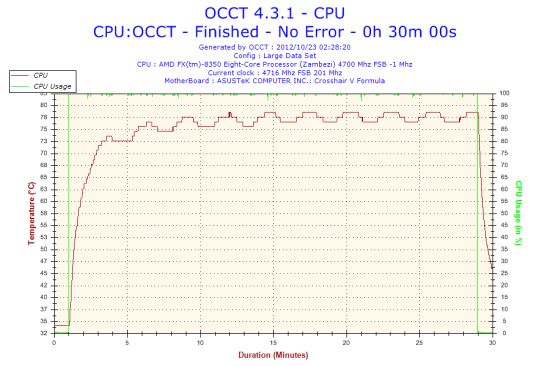
I have to say that during our LinX 0.6.4 stability tests the system power consumption jumped to 350 W, however, this is quite logical.
In fact, this particular test unit proved to be very sensitive to the Vcore increase. However, it only makes sense for short-term experiments to raise its core voltage significantly. Long-term operation at high core voltage settings may eventually cause serious CPU degradation and failure. Therefore, we consider our obtained result to be the optimal one for long-term problem-free use.
So, FX-8350 processor allowed us to increase its clock speed by 18% during overclocking. Of course, this isn’t bad at all, but Intel processors can be overclocked just as well. Therefore, even taking into account the potential overclocking, the comparison between FX-8350 and Core i5-3750K will still end up the same way.
However, in AMD’s official press materials they claim that eight-core Vishera processors can be overclocked to 5.0 GHz. At this frequency FX-8350 can definitely make a much better entrance. Therefore, we will do our best to find and test a unit capable of such overclocking, because they claim that the maximum overclocking frequency of different processors may vary within 200-300 MHz range. So, maybe we simply weren’t that lucky yet.
Conclusion
Back then, a year ago, when we first met the desktop Zambezi processors, it already felt like AMD Bulldozer didn’t really end up in a good spot. We can’t say that AMD’s microarchitecture is flawed. On the contrary, it is very interesting and is capable of delivering very high level of performance in heavy multi-threaded tasks. But the problem is that desktop environments usually require good performance during low-threaded and uneven loads, and this isn’t Bulldozer’s strength, unfortunately.
A year has passed and instead of the original Bulldozer microarchitecture, AMD’s flagship desktop processors acquired the new Piledriver microarchitecture. However, the incompatibility between the typical desktop tasks and the potential of the AMD processors are still there. New FX CPUs, just like their predecessors, cope really well with video transcoding, complex calculations, 3D modeling tasks, but at the same time fall seriously behind their competitors in typical general-purpose tasks and games. In other words, even after the microarchitecture refresh AMD FX remain an excellent option for inexpensive workstations, but aren’t that attractive as universal processors for home and gaming systems.
Of course, AMD engineers tried very hard to fix these inconsistencies while working on their new Piledriver microarchitecture. And a lot of things in Vishera look much more attractive than they were in the previous-generation Zambezi. The new processors are 15% faster, more overclockable and are very appealingly priced. However, in our opinion, the new FX could be a little more versatile, like the competing Core i5 and Core i7 CPUs. The performance of contemporary Intel processors is good under any type of operational load, while AMD’s solution works great in some cases and pretty poorly in others. Moreover, energy efficiency is another bottleneck of the FX processor family. Unlike Ivy Bridge-based platforms, Socket AM3+ system consumes about 1.5-2 times more power.
Nevertheless, we have no doubts that the new processor design keep Socket AM3+ alive and well for at least another year until the new Steamroller microarchitecture comes out. Hopefully, these new processors will finally free flagship desktop AMD processors from their bottlenecks. Particularly, since AMD FX is a pretty good option for some users these days. Some may be excited about their high performance in certain resource-hungry tasks, comparable with the performance of Core i5 and Core i7 CPUs; others may be drawn to their overclocking potential; some users will love their affordable price, and some may feel that time has finally come to upgrade their old Socket AM3+ system. Either way, FX processors will start selling much better once they transition to Piledriver microarchitecture and this success alone will definitely be a worthy achievement for AMD.